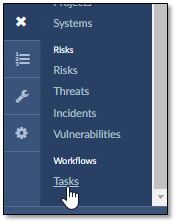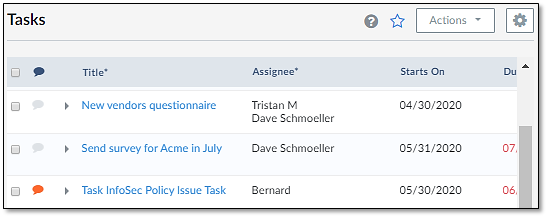Working with Tasks
Tristan Mohn (Deactivated)
Victoria Buhler (Deactivated)
Page Contents
Benefits
The task object provides all the functionality your team needs to stay on top of necessary assignments, whether or not they relate to compliance issues. On top of tasks being effective reminders for important endeavors, task alerts can be set to repeat at nearly any interval you need.
NOTE
Tasks can be linked to issues in Jira. For more information, please see Managing Jira Requests, Tasks and Assessments.
Overview
This documentation highlights additional functionality that audit managers or power users may need. For streamlined steps on how to finish your portion of an assignment, please see Quick Tips for Tasks and Requests.
Accessing Tasks Through the System of Record
To access tasks, complete the following steps.
- Click System of Record | Tasks.

- The Tasks page displays showing all existing tasks.

Accessing Tasks from the To-Do List
The Task Workflow
The workflow of tasks can be set up in many ways. To further your understanding, please see Workflow for Requests and Tasks.
Submitting, Reviewing, and Verifying Information
After opening the task from the To-Do List or System of Record, please follow these instructions Quick Tips for Tasks and Requests.
Creating a Task
Tasks provide a simple way to set up a workflow for your team. For example, you can set up recurring tasks for actions that happen on a periodic basis, such as an annual review of policies. The workflow then triggers reminders for policy owners to update their policies. And reviewers and verifiers can conduct peer reviews for communication between team members or with other teams.
To set up a task, complete the following steps:
- Click System of Record.
- In the subcategory that opens, select the home page for the item needing review, such as Policies or Programs. All items in ZenGRC can have a task created from them.
- Click the linked title for the item.
- In the upper, right corner, there will either be an ellipsis or an Update button. This depends upon your computer resolution. Click and select Create Task.

- Compete the following information:
- Title - Add an appropriate heading so the assignee understands the request.
- Code - This is not a required field. It will auto populate with a generated name upon Save.
- Starts On and Due On date picker - Select applicable dates. The Starts On date is when notifications are emailed to the assignee.
- Tags - If your organization is using tags to group items, select or create a tag. For more information, please see Tags.
- Requester - This field defaults to the person creating the task, but it can be changed if needed.
- Assignee - Select a user in the drop down. This is the person responsible for the assignment.
- Status - This defaults to Open.
- Notify Assignee - To understand this option, please see Enabling Instant Notifications on a New Item.

- Description - Provide enough instruction and information for the assignee to understand the request.
- Reviewers and Verifiers - These are optional fields for users to confirm and verify submitted information. For additional information on this, please see the previous documentation on workflows and statuses.
- Related Objects - This displays the item on which you created the task and is presented as a hyperlink for the assignee to review. Other items that are relevant to the task can be mapped in this field, as well.

- Click Save.
Setting Up a Recurring Task
Requests, assessments and tasks can be set up to repeat on a weekly, monthly, quarterly, semi-annual, and annual basis. Setting up recurrence is the same for requests, assessments and tasks. For more information, please see Setting Recurrence on Action Items.
NOTE
To understand how to complete items that are assigned to you, please see Quick Tips for Assessments and Quick Tips for Tasks and Requests.
© 2021 Copyright Reciprocity, Inc.
https://reciprocity.com